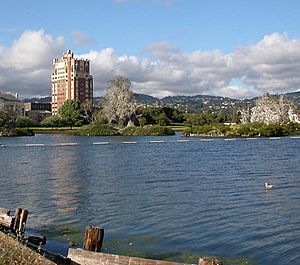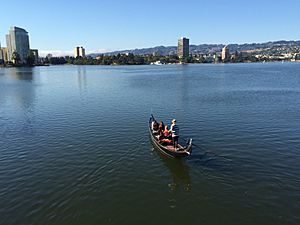Lake Merritt facts for kids
Quick facts for kids Lake Merritt |
|
|---|---|

A view looking west toward the Lakeside Apartments District, the Tribune Tower and Downtown Oakland
|
|
| Location | East of downtown Oakland |
| Coordinates | 37°48′14″N 122°15′33″W / 37.8039°N 122.2591°W |
| Lake type | recreation, lagoon, wildlife refuge |
| Basin countries | United States |
| Surface area | 140 acres (0.57 km2) |
| Max. depth | 10 feet (3.0 m) |
| Shore length1 | 3.4 miles (5.5 km) |
| Surface elevation | 43 feet (13 m) |
| Frozen | No |
|
Lake Merritt Wild Duck Refuge
|
|

Looking Southwest across Lake Merritt. In the distance are the Rene C. Davidson Alameda County Court House and Henry J. Kaiser Convention Center. At the right is the Bellevue-Staten Building.
|
|
| Built | 1870 |
| NRHP reference No. | 66000205 |
| Significant dates | |
| Added to NRHP | October 15, 1966 |
| Designated NHL | May 23, 1963 |
| 1 Shore length is not a well-defined measure. | |
Lake Merritt is a large tidal lagoon located in the heart of Oakland, California. It is surrounded by beautiful parks and city neighborhoods. This lake is very special because it was the first official wildlife refuge in the United States, created way back in 1870!
Lake Merritt is also recognized as a National Historic Landmark since 1963. It has grassy shores, several small islands built for birds, and a nature center called the Rotary Nature Center. You can rent sailboats, canoes, and rowboats at the boating center. There's even a fun, fairy-tale themed amusement park nearby called Children's Fairyland.
Inside Lakeside Park, you'll find The Gardens at Lake Merritt. This 7.5-acre garden has seven different themed areas, like Japanese and Mediterranean gardens. It also has plots where people can grow their own food. Every October, the gardens host the Autumn Lights Festival, showing off amazing illuminated art. A popular path for walking and jogging goes all the way around the lake. The lake is about 3.4 miles (5.5 km) around and covers an area of 155 acres (63 ha).
Contents
History of Lake Merritt
Lake Merritt was originally connected to San Francisco Bay. Several creeks flowed into it, creating a large area of wetlands. The Ohlone people lived here long ago, fishing and gathering food.
In 1852, Oakland became a city. At first, the lake was used as a sewer, which caused a terrible smell for people living nearby.
Dr. Samuel Merritt, who was once the mayor of Oakland and owned land by the lake, wanted to clean it up. In 1868, he paid for a dam to be built between the lake and the bay. This dam helped control the water level and made the water less salty, turning the tidal lagoon into a proper lake. New city projects also helped redirect the sewage away from the lake. The newly cleaned water body was then called Lake Merritt.
The lake still had many wetlands and attracted lots of migratory birds. To protect these birds from hunters and to stop the noise of gunfire near the city, Dr. Merritt suggested making the lake a wildlife refuge. In 1870, the state government agreed, making Lake Merritt the first wildlife refuge in North America. This meant no hunting was allowed, and fishing was only permitted with a hook and line.
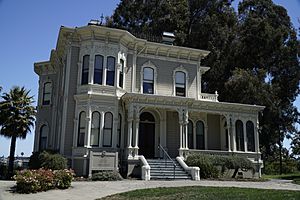
The beautiful Camron-Stanford House was built in 1876 near the lake. Dr. Merritt built it to help develop the area around the new lake. In 1877, Mrs. Alice Camron bought the house. It was one of the first fancy homes built by the lake. From 1910, it was the Oakland Public Museum. Today, it is its own museum.
Over the years, more land around the lake was developed, and the wetlands slowly disappeared. The lake also started to fill with silt because the natural water flow was stopped by the dam. In 1891, dredging (removing silt from the bottom) began. The removed silt was used to build a road along the eastern shore, which became Lakeshore Avenue.
Between 1893 and 1915, Lake Merritt changed a lot. Inspired by the "City Beautiful movement," the lake became a city park. In 1913, a fancy pergola (an archway structure) was built at the northern end. Areas like Adam's Point were turned into Lakeside Park with lawns and trees. Eastshore Park was also created. The Oakland Civic Auditorium was built at the south end of the lake in 1914.
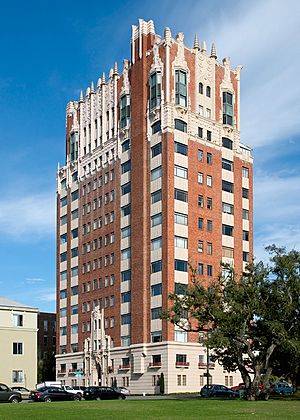
In 1923, the Cleveland Cascade was built. This was a three-level waterfall with many basins and a pool at the bottom. It had colored lights that lit up the waterfall at night. In 1925, the famous "Necklace of Lights" around the lake was turned on for the first time.
In 1929, the tall Bellevue-Staten apartments were finished. This 15-story building, with its mix of Art Deco and Spanish Colonial styles, is a famous sight from almost anywhere around Lake Merritt.
Today, most of the original wetlands are gone, replaced by parks and roads. However, some wetland plants have been brought back to five "Bird Islands." These islands were made from dredged silt between 1925 and 1956. They provide a safe home for hundreds of nesting birds and have a fresh water system for them to drink.
In 1963, the site was named a National Historic Landmark as the Lake Merritt Wild Duck Refuge.
Children's Fairyland is a 10-acre park built in 1950. It's so special that Walt Disney himself visited Children's Fairyland to get ideas when he was planning Disneyland!
Necklace of Lights
| Necklace of lights | |
|---|---|
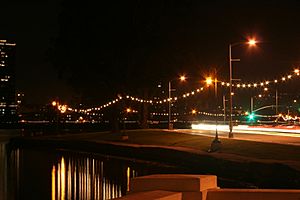 |
|
|
Invalid designation
|
|
| Designated | 1985 |
| Reference no. | 97 |
A beautiful "necklace of lights" goes all the way around Lake Merritt. It has 126 lampposts and 3,400 "pearly bulbs." The lights were first turned on in 1925. They were removed in 1941 during World War II for blackout conditions. After a long effort by the Lake Merritt Breakfast Club, the lights were turned on again in 1987.
During Oakland's yearly gay pride celebration, the city changes the white bulbs to colorful ones.
Wildlife at Lake Merritt
Lake Merritt is home to many birds all year round. The types of birds you see can change with the seasons.
Birds
Year-Round Birds
All year, you can see many Canada geese and a good number of black-crowned night herons, great egrets, snowy egrets, cormorants, American coots, and western gulls. There are also small groups of mallard ducks and pelicans (both American and brown).
Rainy Season Birds
From November to March, a very large number of greater scaup and lesser scaup visit the lake. They spend most of their time floating on the water. A rare bird from Eurasia, the tufted duck, is also seen here every year. Smaller numbers of canvasbacks, redheads, common and Barrow's goldeneye, buffleheads, and other diving ducks are also present during the colder months.
Dry Season Birds
From June to September, the number of Canada geese around the lake grows a lot. You'll see them almost everywhere around the lake's edge. In late summer and early fall, a good number of pelicans also arrive, and Caspian terns can be seen on the lake.
Other Animals
Fish in Lake Merritt include bat rays and gobies. You can also find molluscs like sea hares, bay mussels, and oysters. Crustaceans found here include barnacles and a special type of sand hopper called Transorchestia enigmatica, which is only found in Lake Merritt!
Plants Around Lake Merritt
While native trees like coast live oak and California buckeye are present, most of the park around Lake Merritt has plants from all over the world. This idea of having diverse plants started early, as city planners wanted visitors to see plants from their home countries. The New Zealand tea tree (Leptospermum sp.) is a famous plant here, with its twisted branches growing along the water's edge.
A special area of native plants has been created at the restored tidal marsh, near the Lake Merritt Blvd. bridge. Plants like Pickleweed, saltgrass, and marsh gumplant have been planted here.
Plants that grow in the lake itself include widgeon grass, green algae, sea lettuce, and dead man's fingers. These plants grow a lot by mid-June. When they die, they can cause bad smells and use up oxygen in the water. To prevent this, the city uses a special machine to remove the extra plants during summer. The most common plants in Lake Merritt are tiny, free-floating phytoplankton. Even though the water can look cloudy, it means there's lots of microscopic life, which helps support all the animals and birds at the lake.
Cleanup and Restoration Efforts
One of the biggest problems for Lake Merritt is trash and pollution from storm drains in downtown Oakland. These drains flow directly into the lake. Too many chemicals like nitrogen and phosphorus can cause algae to grow too much, which then uses up the oxygen in the water. To help with this, aeration fountains have been installed. These fountains add oxygen to the water and mix it, making it healthier.
A non-profit group called the Lake Merritt Institute works with the City of Oakland to remove trash. The Institute organizes clean-ups several times a week. People can also use "U-Clean-It" boxes to help clean up on their own, often using long-handled nets. About 1,000 to 6,000 pounds of trash are removed every month! Many volunteers help, including regular Saturday and Tuesday groups, the Peralta Service Corporation, St. Paul's Episcopal School 6th Grade, and HandsOn Bay Area.
Pollution Incidents
Sometimes, more harmful things have spilled into the lake. For example, in 1998, about 20 gallons of diesel fuel leaked into the lake. In 2011, another diesel fuel spill covered five acres of the lake's northwest side. Firefighters and environmental agencies worked to clean up these spills.
Measure DD Improvements

In 2002, Oakland voters approved "Measure DD," a plan to spend $198 million to improve the city's parks, including Lake Merritt. This measure helped add more park space and change the roads around the lake. For example, 12th Street on the south side of the lake used to have many lanes, making it hard for people to walk or bike to places like Laney College and the Oakland Museum of California. Measure DD helped reduce the number of traffic lanes and added more park space and lights.
A lawsuit tried to stop the renovation in 2006 because some residents were worried about cutting trees. However, a judge allowed the renovation to continue in 2007.
One of the first projects, finished in 2007, was fixing up the 1913 pergola at the north end of the lake. In 2008, more work was completed. The 1909 Municipal Boat House was renovated into the Lake Chalet restaurant. Roads were improved, and Lakeside Drive was made narrower with a new bicycle lane. New landscaping was also added along the west and east sides of the lake.
The biggest part of the Measure DD work was the 12th Street Reconstruction Project on the south side. This project, which included replacing the old 12th Street Dam, started in 2010 and was finished in 2013.
A major step in restoring Lake Merritt happened in February 2013. A new 750-foot (230 m)-long channel was opened, with a paved trail and a pedestrian bridge. This channel helps connect Lake Merritt more directly to San Francisco Bay, doubling the amount of water that flows in and out of the lake. In 2016, another culvert (a tunnel for water) was removed to further increase the tidal movement.
Images for kids



